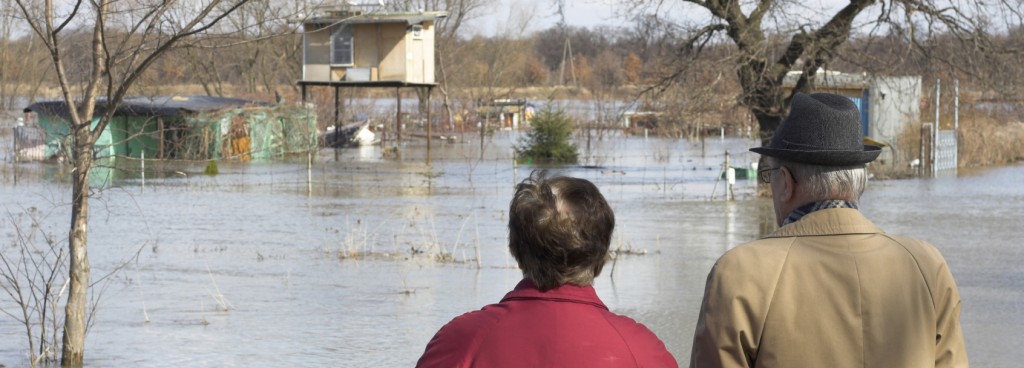The effects of a disaster are not always physical. Houses and roads can be rebuilt and physical wounds will heal, but the emotional scars from a disaster can often be harder to fix.
In 2008 Cedar Rapids, Iowa experienced extreme flooding that wiped out businesses and homes, disrupting daily life and displacing residents. While other groups work on rebuilding the physical structures damages during the floods, the Upper Midwest Preparedness and Emergency Response Learning Center (UMPERLC) has been developing resources to prepare communities for the emotional and psychological needs following a disaster.
Jennifer Bedet is an Instructional Specialist at the UMPERLC and has been working to develop a scenario –based training to help people learn how to respond to emotional and psychological needs in a crisis situation. Below is an account of her work.
The Healing Process
 Although three years has passed, it’s still impossible to drive through Cedar Rapids without seeing reminders of the 2008 floods: abandoned buildings, boarded windows, signs advertising mold remediation contractors. I was on my way to a Psychological First Aid (PFA) training delivered by Johns Hopkins Preparedness and Emergency Response Research Center. The training was held in the basement of an Episcopal Church, where I took my seat at a table. Introductions revealed that most of the other attendees were clergy from around Iowa. The importance of what we were doing that day quickly became clear.
Although three years has passed, it’s still impossible to drive through Cedar Rapids without seeing reminders of the 2008 floods: abandoned buildings, boarded windows, signs advertising mold remediation contractors. I was on my way to a Psychological First Aid (PFA) training delivered by Johns Hopkins Preparedness and Emergency Response Research Center. The training was held in the basement of an Episcopal Church, where I took my seat at a table. Introductions revealed that most of the other attendees were clergy from around Iowa. The importance of what we were doing that day quickly became clear.
Pastors described their experiences as spiritual and community leaders during the catastrophic 2008 floods. “I feel like we did a great job responding to the immediate, physical needs of the community. We were able to provide shelter, food, and water. We had teams of people ready to help with clean up,” said one pastor. “But I don’t think we did so well on the emotional part of things. I see a lot of people today who still have this sort of dead look in their eyes. There’s a sadness.“ Other attendees’ stories echoed this feeling of being underprepared to handle the psychological impact of the disaster.
At the Upper Midwest Preparedness and Emergency Response Learning Center, we developed a scenario-based training to help clergy and other responders implement the PFA model. Using true-to-life situations, users navigate the process of responding to the psychological needs of flood victims. Beginning with reflective listening practice, learners move through immediate needs assessment and prioritization to intervention and disposition, learning how properly to triage, refer and act as an advocate for the affected person.
The online scenario will be available to the public when UMPERLC launches its new Learning Management System in the summer of 2012: http://go.prepareiowa.com/url/em
The Upper Midwest Preparedness and Emergency Response Learning Center is funded by the CDC and works to strengthen the emergency response capacity of the public health workforce through education and training. Visit our website at http://cph.uiowa.edu/umperlc.
Additional Resources
If you’d like additional information on how to cope with a disaster or traumatic event please visit:
http://emergency.cdc.gov/mentalhealth/ http://www.samhsa.gov/disaster/For tips on emergency preparedness and response please follow us on Twitter @CDCReady or join our LinkedIn group Office of Public Health Preparedness and Response



Public Comments
Comments listed below are posted by individuals not associated with CDC, unless otherwise stated. These comments do not represent the official views of CDC, and CDC does not guarantee that any information posted by individuals on this blog is correct, and disclaims any liability for any loss or damage resulting from reliance on any such information. Read more about our comment policy ».
July 13, 2012 at 2:26 pm ET - Christian
Great article & resources! FYI, the Disaster Distress Helpline (a program of SAMHSA) offers 24/7 crisis counseling related to any natural or human-caused disaster in the U.S. and territories. Those needing support can call toll-free 1-800-985-5990 or text TalkWithUs to 66746 (Spanish-speakers can text Hablanos to 66746); calls and texts are answered by trained, caring counselors from call centers located throughout the U.S.
Link to this comment
July 15, 2012 at 8:37 pm ET - Ismath Batcha
Beautiful approach. Everything can be recovered, but not the mental rythm and a happy face. Those involving in this process are doing a divine service. The blog has refined me.
Link to this comment
July 21, 2012 at 1:06 pm ET - Tiffany
As someone who grew up in Iowa (and who plans to travel to this area next week), I was immediately drawn to this blog posting about the emotional response to the 2008 Cedar Rapids/Iowa City floods. I am a University of Iowa graduate and formerly worked downtown Cedar Rapids. I remember sitting is disbelieve while looking at the images of such familiar places underwater. I have since been back to both Iowa City and Cedar Rapids and while I’ve seen the rebuilding and the rejuvenation of these cities, the memories of the flood of 2008 remain palpable. This learning center is a wonderful idea. Clergy and others will be able to learn so much so that they can not only help people move past 2008, but also look ahead with confidence that the future will be OK, even if another flood should arrive.
Link to this comment
AUTHOR COMMENT July 24, 2012 at 12:20 pm ET - Blog Administrator
@Tiffany: Thank you, we’re glad you enjoyed reading this post
Link to this comment
August 30, 2012 at 1:07 am ET - stephenfletcher
@ Thanks for this wonderful Post.
Link to this comment